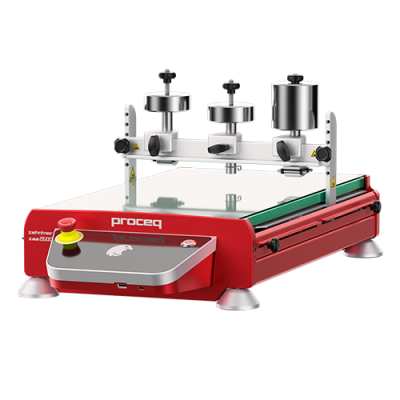ZAA2600.C
ZAA2600C
ZAA 2600 C
Automatic Crockmeter

Crockmeters are linear abrasion testers. In the test process, the crockmeter moves a friction finger with a defined test force over the testing surface in a dual movement (forward and backward motion), the so-called stroke, thus rubbing over the test surface. The friction finger is also called friction journal and abrasive cylinder.
There are various types of rubbing tests described in different standards and test specifications. They have varying requirements on the friction finger, the test force, the stroke length, stroke speed, number of double strokes and other test conditions. Some demand the use of a levelling material and/or scratching material between the friction finger and the test surface. Another used term for those is „friction material“. The friction material can be dry or wet.
Below you find the most common rubbing tests:
Colour fastness to rubbing
The term colour fastness refers to two resistance criteria of a colour of a test sample. The first criterion is the resistance of a material to change in any of its colour characteristics. The second criterion is the resistance of its colourant(s) to adjacent materials as a result of exposure of the material to any environment that might be encountered during the use of the material.
The first resistance criterion is checked by the “rubbing fastness” test. The term “rubbing fastness” is the term for the hue change of the test sample through rubbing. This test is evaluated visually with a comparative scale. Most common is the use of a “gray scale for staining”.
“Crocking” and “smudging” are both equivalent terms for the transfer of colorant(s) from the test surface to another surface or to an adjacent area by rubbing. Therefore, if the second resistance criteria is checked, you test the crock resistance (equally called smudge resistance).
Abrasion resistance
(Wet abrasion resistance, dry abrasion resistance)
Abrasion resistance is the ability to withstand the frictional forces attempting to remove the surface material.
Scratch resistance
(Wet scratch resistance, dry scratch resistance)
The standard DIN 55654 uses the term scratch test for the determination of the difference of the test surface before and after the test with a measuring instrument. Presently, glossmeters, haze meters and brightness meters are the most commonly used instruments. However, as the friction finger rubs and does not scratch (no cutting into the coating) the term scratch in relation to crocking tests is not the best choice. The DIN 55654 is currently under revision and it is considered to change the term to rubbing test. It is not a crocking test if a real scratch is carried out e.g. as the scratch resistance test described in DIN 55656. Nevertheless, if equipped with the specific options, the model ZAA 2600.C Automatic Crockmeter can be used for carrying out scratch and mar resistance tests in accordance with DIN 55656.
Resistance to solvents
When testing the solvent resistance of a surface it is checked how much of the coating remains after a defined number of double strokes.
Equipment needed for crockmeter tests
For crockmeter tests we offer the models ZAA 2600.C Automatic Crockmeter and ZAA 2600.SW Automatic Scrub Tester.
Other ZAA 2600 models (e.g. Automatic Film Applicator, article No.: 2600.A) are suitable for crockmeter tests as well if equipped with the optional item ACC1285 modification set „Crockmeter“.
In order to carry out crockmeter tests, at least one friction finger set and one weight are needed. Some standards / test requirements specify additional equipment and accessories. We provide an overview of this in our product leaflet ZAA 2600.C
(depending on used accessories)
Product standards:
Application standards:
ZAA2600.C
ZAA2600C
ZAA 2600 C
Automatic Crockmeter